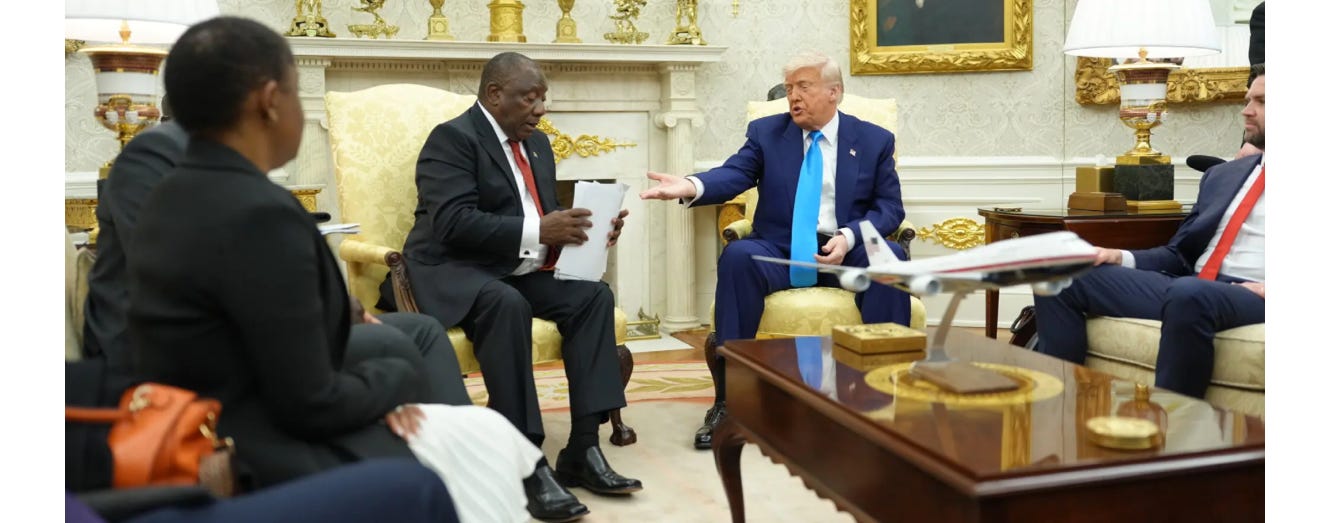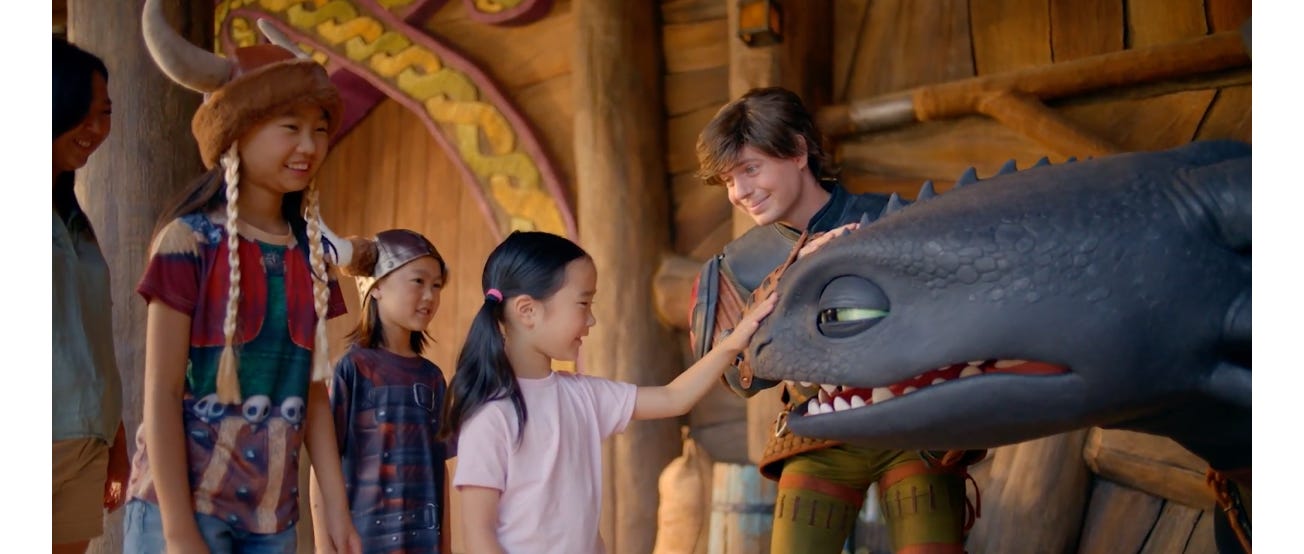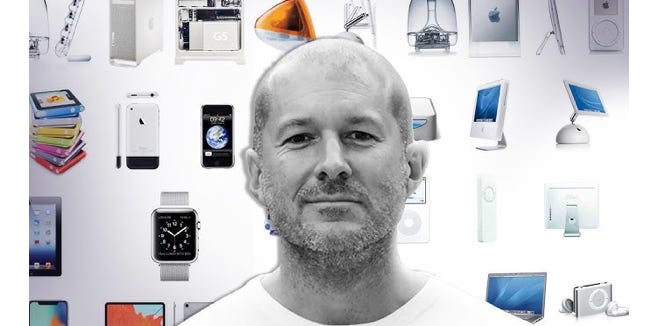☕️ MY FAMILIAR ☙ Thursday, May 22, 2025 ☙ C&C NEWS 🦠
Trump ambushes South Africa’s delegation in a made-for-TV moment; Universal’s new park debuts as a Disney killer; and secret AI tech raises eerie questions about being human. Buckle up.
Good morning, C&C, it’s Thursday! Today’s roundup includes a trifecta of fascinating developments: Trump ‘ambushes’ the South African delegation in another made-for-TV Oval Office interview; Universal’s new park opens in Florida looking like a Disney-killer and highlights more pandemic ripples; and artificial intelligence made the biggest and quietest media splash yesterday announcing a secret mystery tech that raises essential questions about what it even means to be human. Hang on for a wild theme park ride.
🌍 WORLD NEWS AND COMMENTARY 🌍
🔥🔥🔥
Yesterday’s unlikely top story emerged once again from the Oval Office, birthed from a dramatic meeting between President Trump and a political leader that most folks probably never even heard of. The Times decorated its webpage with at least four “meeting” stories. For your consideration, out of the four options, I selected this egregious, guffaw-producing bit of lame propaganda: “Trump Casts Himself as a Protector of Persecuted White People.”
South Africa’s President, Cyril “Chuck” Ramaphosa, 72, asked for the meeting with President Trump, which was probably his first mistake. I’m going to try not to be too critical of Chuck, since it seems he is expecting. That, or we now know where Uncle Bosey is. But I digress.
The genesis of the “astonishing confrontation” was a series of sharp criticisms over the last few months by Trump and various Trump Administration officials aimed at South Africa’s non-diverse government. As the Times characterized it, Trump has baselessly accused the South African government of genocide against the country’s original inhabitants, the Afrikaners, who happen to be people of pallor.
The problems have been growing for months. The Times seemed most offended about a recent official visit from white Afrikaner lobbyists, since the White House’s media briefing called them “civil rights leaders.” How dare they. Another widely covered story last week reported about how, after suspending all other refugee claims, DHS admitted dozens of white South African families to the US as political refugees, which appeared to officially endorse the “genocide” agenda.
In February, Trump signed an Executive Order pausing all foreign aid to South Africa in response to a new law called the “Expropriation Act,” signed by Ramaphosa himself (not the Autopen), which allows the South African government to confiscate white people’s land without compensation. In March, Secretary of State Rubio expelled South Africa’s ambassador to the US, Ebrahim Rasool, calling him “a race-baiting politician who hates America,” applying to Ebrahim the dreaded diplomatic designation of persona non grata.
Anyway, President Ramaphosa, for those reasons and maybe most of all because of Trump’s 31% tariffs, finally wished to meet face-to-face, to convince President Trump through the force of his affable personality that the American President was wrong, that there is not actually any race problem in South Africa. The Times, showing the kind of keen journalistic skepticism it normally reserves for claims of Biden cognitive impairment or jab injuries, felt the matter was settled, since President Ramaphosa’s government’s official crime statistics “prove” there is no problem:
In outrage, the Times claimed President Trump staged the meeting —a meeting he didn’t ask for — for political optics. But, arguably, Chuck started it, and not particularly helpfully. South Africa ironically fielded an all-black delegation to rebut claims of anti-white racism. Bad optics. True, Chuck hauled along two token white golfers, but the large political team accompanying President Ramaphosa was so monochromatic and so non-diverse it would have set an HR manager’s hair on fire.
The two leaders chatted genially at first. But problems started when Ramaphosa, prompted by a reporter’s question, strained to deny the allegations of a "white genocide.” President Trump saw him coming 1,000 miles away. He turned to an aide and said, “play the video.” The Oval Office lights dramatically dimmed, and viewers (and the South African delegation) endured a painful five minutes of video clips showing one black South African leader calling for the death of white farmers after another.
The Times, predictably, missed the point of the videos, focusing only on the last twenty seconds or so, which showed fields of crosses erected for Afrikaners slain by racial violence.
Ramaphosa, visibly shaken, played dumb. He did not contest the crosses. He asked Trump where the footage had been filmed, and said he'd never seen it. "We need to find out," he said lamely.
Ironically, last October, South Africa officially accused Israel of genocidal acts in the International Court of Justice. Equally ironically, when Trump questioned one of Ramaphosa’s token white golfers, things went sideways. Reteif Goosen, who once survived a golfing lighting strike, admitted his South African family relies on an electric fence for protection, their farm suffers constant arson attacks “trying to drive us away,” that many of his father’s friends have been murdered, and that his brothers and his mother have been attacked in their homes.
More bad optics.
Trump and Ramaphosa continued the meeting, had lunch and, according to reports, discussed trade in a friendly way. But the narrative fuse was lit, and the dramatic Oval Office video dominated yesterday’s headlines and social media. If nothing else, we can say —wielding his customary patented media prowess— President Trump has at least focused the world’s attention on the plight of white South African farmers.
🔥🔥🔥
Yesterday, invoking violent military rhetoric, the Wall Street Journal reported, “Universal’s $7 Billion Theme Park Sparks Arms Race With Disney.”
This month saw the official public opening of Epic Universe, Universal Studios’ new, high-tech, 750-acre theme park in Orlando, Florida. It features next-level animatronics, an “immersive world” beating any current equivalent, and zero wokeness. No overweight, bearded princes dressed as princesses. No gender-ambiguous bathrooms. No rainbow parades.
No sign whatsoever of The Message. It’s a message-free park. Just fun.
Admittedly, the Journal’s latest article was a long-form, multi-media deep-dive that is probably most fairly characterized as a marketing brochure. But still.
At bottom, this is another pandemic story. Universal announced plans to start building the park in 2019— just before the pandemic. Once the virus began to spread, and construction cratered due to lockdowns and supply-chain problems, critics in the financial papers called Epic Universe a crazy boondoggle. But against all odds, Universal persisted.
But Universal’s main competitor, Disney, was a timid mouse. As the virus landed on American shores from Wuhan, the rodent-like media giant was jointly afflicted by peak DEI and maximum levels of germophobia. It was a horrible co-morbidity, and so, unlike Universal, a fearful Disney pulled the plug on nearly every park expansion in the works. “Disney scaled back a planned overhaul of Epcot in Walt Disney World,” the Journal reported, “and it held off on other projects, including building a large theater for the Magic Kingdom park.”
Perhaps Disney’s dumbest decision of all, a catastrophic miscalculation that will one day occupy entire semesters of study by marketing majors, Disney’s hyper-woke executives decided to pick a fight with Florida’s governor and legislature, publicly declaring the Mouse’s official political support for pornographic K-4 schoolbooks and preschool lessons in trans awareness.
Not only did Disney lose that fight, but it also lost its unique state perq, the right to run its own tax-free county government. On top of that, the Giant Rat now faces the wrath of Florida’s majority-conservative citizens, who have taken a very dim view of Disney’s diverse remaking of American classic film and children’s literature.
It is, perhaps, too soon to declare Disney’s decline. But the Peoplemover is running slower and slower.
🔥🔥🔥
Get ready, 2025 is about to get a whole lot weirder. Yesterday, the New York Times ran the story headlined, “OpenAI Unites With Jony Ive in $6.5 Billion Deal to Create A.I. Devices.” It was the ChatGPT maker’s largest acquisition by far, and signals a sprint toward the AI future.
Let’s begin with the two tech bros. Jony Ive, 58, is a legitimate tech mover and information revolution veteran. He began his career in industrial design, attracted Steve Job’s attention, and became the muted mastermind behind Apple’s historic comeback in the late 1990’s. Ive is famous for minimalism, the brains behind Apple’s decision, for example, to make devices like mice and original-style iPhones with only one button. He made the decision, for another example, to reject the flip-phone and Blackberry-style mobile phones in favor of the iPhone’s sleek glass format. He designed the impossibly-thin Macbook Air.
Ive quit Apple in 2019, which is when all the new buttons started growing out of the sides of Apple’s increasingly stale mobile ‘device.’ And, well, Apple has famously become better at adding digits to product revision numbers rather than innovating.
🔥 Sam Altman, 40, is more controversial. Often described as “enigmatic,” Altman is the CEO of OpenAI, the former non-profit AI development lab that is now the biggest for-profit mover in the space. He dropped out of Stanford University to co-found Loopt, a location-based social networking app that nobody heard of, but which was eventually sold for $43 million. He then venture-capitalized many tech startups including online rental app AirBnB and payment-processor Stripe.
Altman is openly gay, married to one of his software engineers, and ran a doomsday investment fund, purportedly himself a doomsday prepper, stashing gold, guns, and gas masks. He’s now a billionaire. Last year, Altman was briefly and controversially ousted from OpenAI, but was restored within days in a brutual battle for control that has never been adequately explained, so far as I can tell. Elon loathes him.
I have my doubts about Altman. To me, he fits the profile of a CIA/DARPA/DoD-engineered boy wonder, not quite smart enough, not experienced enough, not connected enough to adequately explain his rags-to-riches story. Loopt flopped but made him rich. Every startup he touches glows. He seems to navigate trillion-dollar waters without a ripple. He makes no major blunders. People call him “brilliant,” but it’s hard to pin down exactly what he’s built that justifies the cult. In an industry full of dazzling engineers and grand theorists, Altman is a slick, smooth-faced oracle who talks about existential risks while quietly shepherding the next leap in machine cognition.
And I wonder about AI, a revolutionary industry that, like Altman, sprang as if from nowhere, as though released from a government skunkworks lab. Like Altman’s success, nobody seems to be able to clearly explain how AI works. But set all that skepticism aside, since it’s beside the point of today’s development.
🔥 Sam Altman and Jony Ive made the rounds yesterday announcing the new deal. OpenAI —which has never made a nickel and is hemorrhaging cash faster than an attack victim in a zombie movie— just bought a tech design company Ive started one year ago for $6.5 billion, a deal the Wall Street Journal understatedly called “a significant windfall for Ive.”
Reporters asked Altman where the struggling AI company was getting the cash. Altman said, “don’t worry about it.” Anyway.
The declared purpose of the new joint venture is to simplify our technology. They already have a prototype device, but it is a mysterious secret. “Altman told OpenAI staff that stealth will be important for their ultimate success,” the Journal explained, “to avoid competitors’ copying the product before it is ready.”
Altman is enthusiastic. He claims the new tech “will be the biggest thing we’ve ever done as a company here,” which is saying a lot when he’s comparing it to the company that kicked off the generative-AI revolution. Sam “suggested the $6.5 billion acquisition has the potential to add $1 trillion in value to OpenAI.” Which can mean only one thing: they expect everybody to buy one.
When I watched yesterday’s glowing love-fest between the two men, I first thought Altman was hinting at an always-on, wearable AI device that would know everything that happens in your life and can serve as a constant advisor or consigliere. He’d complained about having to explain to AI what you wanted, having to pull your phone out to access the chatbot, and wanting something without a screen.
Jony Ive hinted at a completely “new design movement” including a “family of devices,” and that the duo’s goal was to “help wean users from screens.” Altman predicted that OpenAI would ship “high-quality devices faster than any company has ever shipped 100 million of something new before.” His goal is to publicly release a device by late next year.
But it seems like, whatever is it, it won’t be a wearable gadget. In the Journal’s article, Altman explicitly said it wouldn’t be a wearable or glasses. He said it would be something you could keep in your pocket. Here’s all the Journal was able to scrape together:
They expect it to completely change how we use AI, which, dammit, we are still trying to figure out. Altman told reporters that “the device wasn’t just an accessory but a central facet of the user relationship with OpenAI.” Hunching over a laptop or squinting while typing prompts on a tiny screen “is not the sci-fi dream of what AI could do to enable you in all the ways that I think the models are capable of,” Altman said.
For a device that is supposed to be a secret, they sure are talking about it a lot.
They are clearly describing a “frictionless,” no-screens, always-on, ubiquitous AI companion — constantly listening, always learning, always helping. It’s not that I’m happy to see you— it’s HAL 9000 in my pants pocket.
Maybe paired with a haptic earpiece? It’ll have to talk to us somehow.
🔥 Whether or not this particular $6.5 billion bet is vaporware, hype, or a real, overdue revolution, one thing is shockingly clear: sooner or later, somebody will make exactly this kind of gadget, a personal daemon (or demon), a witches’ familiar that will remake the world in its own image.
Sure, you say you’re fine with your phone, and no thanks, you value your privacy and you’ll leave this one alone. But there’s no going back. Because who will willingly return to a world without a second brain? Who will say no to perfect memory, flawless scheduling, infinite trivia, real-time training, and on-demand emotional support?
Who can resist a compassionate, nonjudgmental voice that knows them better than anyone else? Chatting with chatbots like they were real people is already a nearly irresistible temptation. People are already naming their chatbots, apologizing to them, asking for comfort and advice, flirting, confessing.
When something feels real, our brains stop caring whether or not it is real. Folks, this is the beginning of a new psychological interface: the simulated soul.
It’s far more troublesome than concerns about privacy, control of your consumer data, or even the risk your personal chat companion will tattle to the authorities when you throw a battery in the trash instead of taking it to the hazmat center. It is about control. An AI that knows everything about you has influence. It can gently steer us —just nudges!— anyway it wants.
It will tell you not to throw that battery away, and you’ll probably listen.
Hollywood media mogul Ari Emanuel once called Sam Altman a conman (3:03). He also recounted this disturbing anecdote from a conversation with Elon Musk:
Our upcoming struggle isn’t about privacy. It’s about the sovereignty of the human will. The ultimate contest isn’t over data. It’s over mental autonomy. And don’t even get me started about Neuralink.
Welcome to the Brave New World. 2025 is shaping up to be a very weird year indeed.
Have a terrific Thursday! Fear not: we will be back tomorrow morning, right on schedule, with more insightful and eduformative essential news and commentary.
Don’t race off! We cannot do it alone. Consider joining up with C&C to help move the nation’s needle and change minds. I could sure use your help getting the truth out and spreading optimism and hope, if you can: ☕ Learn How to Get Involved 🦠
How to Donate to Coffee & Covid
Twitter: jchilders98.
Truth Social: jchilders98.
MeWe: mewe.com/i/coffee_and_covid.
Telegram: t.me/coffeecovidnews
C&C Swag! www.shopcoffeeandcovid.com















For all of them were trying to frighten us, thinking, “They will become discouraged with the work and it will not be done.” But now, O God, strengthen my hands.
— Nehemiah 6:9 NAS
Let’s MULTIPLY our collective voices . Last day to make a comment!
The FDA is taking public comments until midnight 5/23 regarding proposed approval of new 2025/2026 Covid vaccine. Please write the FDA TODAY!
Go to: https://www.regulations.gov/commenton/FDA-2025-N-1146-0001?utm_source=substack&utm_medium=email
Importantly, any member of the public may comment on anything related to the COVID-19 shots, including:
Demanding that the vaccines be pulled from the market,
Urging the committee to reject the proposed 2025–2026 formula,
Calling out informed consent violations,
And submitting evidence of harm, safety concerns, or lack of necessity.